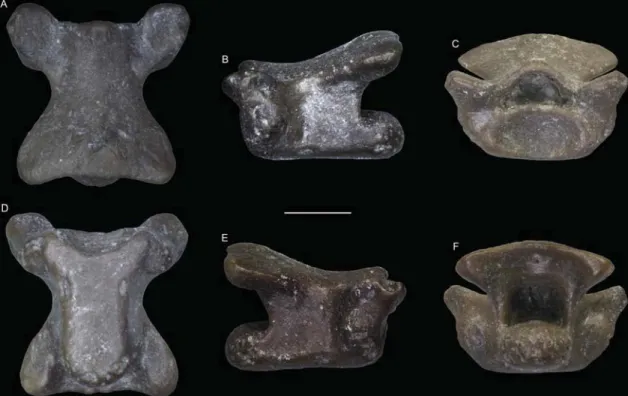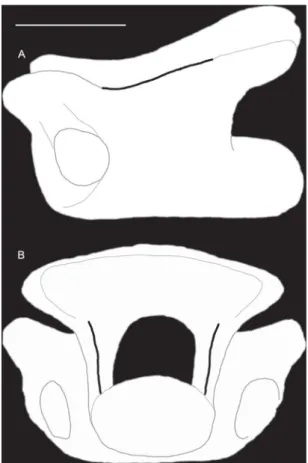The last amphisbaenian (Squamata) from continental Eastern Europe
Le dernier amphisbaenien (Squamata) d’Europe de l’Est continentale
Georgios L. Georgalis
a,b,∗, Andrea Villa
b, Massimo Delfino
b,caDepartment of Geosciences, University of Fribourg, 6, chemin du Musée, 1700 Fribourg, Switzerland
bDipartimento di Scienze della Terra, Università di Torino, 35, via Valperga Caluso, 10125 Torino, Italy
cInstitut Català de Paleontologia Miquel Crusafont, Universitat Autònoma de Barcelona, Edifici ICTA-ICP, Carrer de les Columnes s/n, Campus de la UAB,
08193 Cerdanyola del Vallès, Barcelona, Spain
Keywords: Squamata Amphisbaenia Neogene Extinction Biogeography Europe
a b s t r a c t
The fossil record of amphisbaenians in Europe has recently been augmented through the description of new finds across the continent. It has been suggested that the post-Miocene range of amphisbaenians fol-lowed a progressive southward constriction that ultimately lead to their extant disjunct distribution. We herein describe amphisbaenian vertebral material from the Pliocene of northern Greece, which demon-strates that these reptiles were still present in the late Neogene of the southern Balkans. The new find represents the youngest occurrence of amphisbaenians in continental Eastern Europe and further high-lights the role of the Greek area as a biogeographic “refugium” for certain reptile groups during the late Neogene and Quaternary.
Mots clés : Squamata Amphisbaenia Néogène Extinction Biogéographie Europe
r é s u m é
Les archives fossiles des amphisbaeniens en Europe ont récemment été augmentées grâce à la description de nouvelles découvertes à travers le continent. Il a été suggéré à plusieurs reprises que l’extension des amphisbaeniens post-Miocène a subi une réduction progressive vers le sud qui a finalement conduit à leur distribution disjointe actuelle. Nous décrivons ici une vertèbre d’amphisbaenien du Pliocène du nord de la Grèce, ce qui démontre que ces reptiles étaient présents dans le Néogène tardif du sud des Balkans. La nouvelle découverte représente la plus récente occurrence d’amphisbaeniens en l’Europe de l’Est continentale et met davantage en évidence le rôle de la région grecque en tant que« refuge » biogéographique pour certains groupes de reptiles pendant le Néogène tardif et le Quaternaire.
1. Introduction
Amphisbaenians (or worm lizards) are squamates characterized by a peculiar external morphology and skeletal anatomy, and are currently distributed in various parts of Europe, Africa, Western Asia, and North, Central, and South America (Estes, 1983;
Kear-ney, 2003). In the extant European herpetofauna, amphisbaenians
are currently represented solely by the genus BlanusWagler, 1830
∗ Corresponding author at: Department of Geosciences, University of Fribourg, 6, chemin du Musée, 1700 Fribourg, Switzerland.
E-mail address:dimetrodon82@gmail.com(G.L. Georgalis).
(Sindaco and Jeremˇcenko, 2008; Sillero et al., 2014; Speybroeck
et al., 2016). Within Blanus, two different species complexes are
currently recognized that are also reflecting their highly disjunct geographic distribution: the Blanus cinereus complex in the Iberian Peninsula and northwestern Africa (Albert and Fernández, 2009;
Ceríaco and Bauer, 2018) and the Blanus strauchi complex in
Ana-tolia and parts of the Middle East, but also present in certain islands in the southern Aegean Sea (Sindaco et al., 2014). Nevertheless, the fossil record already attests a much more diverse amphisbaenian European fauna with a much broader geographic distribution since at least the early Paleogene, with Late Cretaceous records also exist-ing (Rage, 1999; Augé, 2005, 2012; Blain et al., 2010; Folie et al., 2013). The post-Miocene distribution of European amphisbaenians
Published in "Annales de Paléontologie 104 (2): 155–159, 2018"
which should be cited to refer to this work.
showsagradualsouthwardconstrictionoftheirrangeto Mediter-raneanEurope(Delfino,1997,2003;DelfinoandBailon,2000;Blain etal.,2007).However,allPlioceneandQuaternaryamphisbaenian recordsweresofarsolely confinedtotheWesternandCentral partsofMediterraneanEurope(Delfino,1997,2003;Delfinoand
Bailon,2000;Blainetal.,2007).CoevalrecordsfromtheBalkans
weretotallyabsent,whereasasporadicoccurrencefromAnatolia alsoexists(RageandSen,1976).Weheredescribean amphisbae-nianvertebrafromtheearlyPliocene(MN15)ofSpilia-4localityin northernGreece,whichdemonstratesthatamphisbaenianswere presentinthesouthernBalkanPeninsulaaswell,andfurther rep-resentstheiryoungestoccurrenceincontinentalEasternEurope. Wefurtherdescribeandfigure,forthefirsttime,vertebrallaminae onamphisbaenianvertebrae,followingtheterminologythathas recentlybeensuggestedforlacertidlizards(Tschopp,2016).
Institutionalabbreviations:MDHC,MassimoDelfino Herpetolog-icalCollection,UniversityofTorino,Torino,Italy;UU,Universityof Utrecht,Utrecht,TheNetherlands.
2. Materialandmethods
Thesingleamphisbaeniantrunkvertebra,whichformsthebasis of this study,was foundin the locality of Spilia-4 in northern Greece.Thematerialispermanentlycuratedinthecollectionsof theDepartmentofEarthSciencesofUUandisaccessionedunder thecollectionnumberUUSP4501.Comparativematerialconsisted ofextantskeletonsofamphisbaenianshousedinMDHC. Anatom-icalterminologyofvertebralstructuresfollowsEstes(1983)and
Augé(2005)andterminologyofvertebrallaminaefollowsTschopp
(2016).Regardingtheterminologyofvertebrallaminae,itisworth
noting that Tschopp (2016, his figure 1) depicted the centro-postzygapophysealandthespinopostzygapophyseallaminaeinan erroneousinvertedway,whereastheyarecorrectlydefinedand theirterminologyisratherclearinhismaintext(thenamesofthe laminaearealsoself-explanatoryevenfromanetymologicalpoint ofview).
3. Locality
Thelocalityof Spilia-4is situated nearthecityof Serres, in theadministrativeregionofCentralMacedoniainnorthernGreece (Fig.1).Spilia-4belongstotheSpiliaFormationoftheStrymon(or Serres)Basin,alongwiththeadjacentlocalitiesofSpilia-0, Spilia-1,andSpilia-3(VanDerMeulen andVanKolfschoten,1986;de
Bruijn,1989;Koufos,2006).Atitslowerpart,theSpiliaFormation
consistsofsands,marlsandoccasionallignites,whereasatitstop thereisanincreasingamountofconglomerateswithcrystalline material(deBruijn,1989).AlldifferentlocalitieswithinSpiliaare ofearlyPlioceneage,withSpilia-0andSpilia-1beingtheoldest (MN14),whereasSpilia-3andSpilia-4areyounger(MN15),mostly datedonthebasisofmicromammalfinds(deBruijn,1989;Koufos, 2006).ThemicromammalfaunaofSpilia-4comprisesonlyrodents, pertainingtomurids,glirids,andarvicolids,whereasnolarge mam-malshavebeenrecoveredsofar(Koufos,2006).Nosquamatesor otherreptileshadbeendescribedsofarfromSpilia-4orthe adja-centSpilialocalities.Tothecontrary,withintheStrymonBasin,in thenearbyLefkonformation,theolderlocalitiesofAnoMetochi (MN13)andMaramena(MN13/14)havealsoproducedabundant
Fig.1.MapofGreecewiththeblackcircleindicatingthelocalityofSpilia-4.TheblackfillingincertainAegeanIslandsandpartsofAnatoliaindicatetheextantdistribution
ofBlanusstrauchiinthearea.
CartedelaGrèceaveclecerclenoirindiquantlalocalitédeSpilia-4.LeremplissagenoirdecertainesÎlesdelamerÉgéeetdecertainespartiesdel’Anatolieindiquelarépartition
Fig.2.Trunkvertebra(UUSP4501)ofAmphisbaeniaindet.fromSpilia-4,indorsal(A),leftlateral(B),anterior(C),ventral(D),rightlateral(E),andposterior(F)views.Scale
baris1mm.
Vertèbredorsale(UUSP4501)d’Amphisbaeniaindet.deSpilia-4,envuesdorsale(A),latéralegauche(B),antérieure(C),ventrale(D),latéraledroite(E)etpostérieure(F).L’échelle
représente1mm.
squamateremains(Richter,1995;Szyndlar,1995;Georgalisetal.,
2017a). 4. SystematicPalaeontology ReptiliaLaurenti,1768 SquamataOppel,1811 AmphisbaeniaGray,1844 Amphisbaeniaindet.
Material:UUSP4501,atrunkvertebra(Figs.2and3).
Locality: Early Pliocene (MN 15) of Spilia-4 locality, Central Macedonia,Greece.
Description:UUSP4501isasmalltrunkvertebra,witha cen-trumlengthequal to 2.4mm (Fig. 2).The vertebralcentrum is procoelousanddorsoventrallycompressed.Ithasaflatventral sur-faceandsubparallellateralmargins.Tworatherlargesubcentral foraminaarepresentnearthesidesoftheventralsurface,atone thirdofthecentrumlength.Thecotyleiselliptical.Thecondyle iseroded,buttheoriginalellipticalshapeisstillrecognizable.In anteriorview,theneuralcanalissubtriangularandsmallerthan theanteriorcotyle.Thelateralwallsoftheneuralarchare mod-eratelyrobust.Becauseofthisrobustnessandoftheflatanterior surfaces,thelateralwallsoftheneuralarchdonotformtrue cen-troprezygapophyseallaminaeanteriorly.Ontheotherhand,they growthinnerposteriorly,formingmoderatelyrobust centropostzy-gapophyseallaminae (Fig. 3B). Laterally,there areno posterior centrosynapophyseallaminae.Thesynapophysesareeroded. Nev-ertheless,itisstillpossibletorecognizetheirmassiveandrounded shape.Thedorsalsurfaceoftheneuralarchisweaklyconvex, lack-inganeuralspine.Inlateralview,theneuralarchrisesdistinctly withagentlecurvetowardstheposteriorend.Indorsalview,the archisconstrictedinthemiddle.Theanteriormarginofthearch isstraight,whereastheposterioroneisslightlyconcave.In ante-riorview,theanterior margin ofthearch hasa rounded edge,
thereforenot formingarealinterprezygapophyseal lamina.The posteriormarginisslightlymoresharpenedinposteriorview,even thoughrealspinopostzygapophyseallaminaearenotpresent(also becauseoftheabsenceoftheneuralspine).Thereisnozygosphene andnozygantrum.Thezygapophysesarerobustandmoderately largeincomparisontotheoverallsizeofthevertebra,andthey areratherslightlytiltedindorsaldirection.Inlateralview,each prezygapophysisisconnectedtotherelatedpostzygapophysisbya ratherlowpostzygoprezygapophyseallamina(Fig.3A).The prezy-gapophysealfacetsaresubcircular,whereasthepostzygapophyseal onesaresubovalandslightlyanteroposteriorlyelongated.The lat-eralmarginsoftheprezygapophysesaredamagedandsoitisnot clearwhethersmallprezygapophysealprocesseswerepresentor not.
Remarks:ThevertebrafromSpilia-4canbeassignedto Amphis-baeniaonthebasis ofthefollowing combinationof characters: dorsoventrallycompressedcentrumwithaflatventralsurfaceand roughlyparallellateralmargins,massiveandrounded synapophy-ses,absenceofzygosphene,andadorsallyweaklyconvexneural archlackinganeuralspine(Estes,1983).Currently,noclear diag-nosticfeatureallowingidentificationatfamilylevelisknownfor isolatedtrunkvertebraeofthisgroupofsquamates(Estes,1983;
Augé,2005,2012;Georgalisetal.,2016c,2018a).
5. Discussion
Fossilamphisbaenians fromtheNortheasternMediterranean region(BalkansandAnatolia)weresofarrestrictedto indetermi-natevertebralmaterialfromthelateMiocene(MN9)ofPlakias, Crete(Georgalisetal.,2016c)andthePliocene(MN15)ofC¸alta, Anatolia(RageandSen,1976),whereascranialmaterialfromthe middleMiocene(MN7/8)ofGebeceler,Anatolia(Georgalisetal.,
2018a)andthemiddleMiocene(MN7/8)ofTaut¸,Romania(Venczel
Fig.3.Trunkvertebra(UUSP4501)ofAmphisbaeniaindet.fromSpilia-4,inleft
lateral(A)andposterior(B)views,indicatingtheleftpostzygoprezygapophyseal
lamina(A)andthecentropostzygapophyseallaminae(B).Thelaminaeare
repre-sentedbyathickblackline.Scalebaris1mm.
Vertèbredorsale(UUSP4501)d’Amphisbaeniaindet.Spilia-4,envueslatéralegauche
(A)etpostérieure(B),montrantlalamepostzygoprézygapophysairegauche(A)etles
lamescentropostzygapophysaires(B).Leslamessontreprésentéesparunelignenoire
épaisse.L’échellereprésente1mm.
Blanus inthe areaasearlyas themiddle Miocene.Despite the factthatBlanusstrauchi(Bedriaga,1884)occurstodayincertain GreekIslands oftheAegeanSea(Sindacoetal.,2014)andthat amphisbaenianswere,asnotedabove,presentintheMioceneof theIsland of Crete(Georgalisetal.,2016c), noamphisbaenians (extinctorextant)hadeverbeenrecordedfromthemainlandof Greece.ThenewamphisbaenianfromSpilia-4demonstratesthat thesesquamatesachievedamuchwidergeographicdistribution during theNeogene, which encompassedalsonorthernGreece. Nevertheless,thepresenceofamphisbaeniansinthePlioceneof northernGreeceisconsistentwithasouthwardwithdrawalofthe EuropeanrangeofwormlizardsduringthelateNeogene,ashas alreadybeenpreviouslysuggested(Alexander,1966;Delfino,1997,
2003; Bolet etal.,2014; Georgaliset al.,2018a), but thisrange
is hereindemonstrated forthefirst timetoconfidentlyinclude alsothesouthern Balkans.In anycase, suchbiogeographic pat-ternofamphisbaeniansisfullyconcordantwithsimilarsouthward range withdrawals observedfor otherreptileclades duringthe Plio-Pleistocene,suchaspan-trionychids,geoemydids,large-sized testudinids,agamids,thelarge-sizedanguidPseudopus,varanids, scolecophidians, erycine booids, elapids, and “Oriental Vipers”
(SzyndlarandRage,1990;Szyndlar,1991;BailonandBlain,2007;
Chesietal.,2007;Delfinoetal.,2008;GeorgalisandKear,2013;
Georgalisetal.,2016a,2017b,2018a;GeorgalisandJoyce,2017).
Especially asit concerns Greece and thesouthern Balkans,this areahasrepeatedlyservedasabiogeographic“refugium”formany reptiles:indeed,severaloftheabovementionedcladescurrently
have theirsole extant Europeanranges only in that area(e.g., agamids,Pseudopus,scolecophidians,“OrientalVipers”,anderycine booids)(Szyndlar,1991;Delfinoetal.,2008;Georgalisetal.,2016a), whereasothers,whicharenowlocallyextinct,havetheiryoungest fossiloccurrences fromthe continent alsofrom that area(e.g., varanids)(Georgalisetal.,2017b).Notethatarecentlydescribed populationofEryxjaculus(Linnaeus,1758)fromSicilycouldmost probablybetheproductofhumantransportationduringAntiquity, however,thishypothesishasstilltobeevaluated(Insaccoetal.,
2015).
Amphisbaenianvertebraecanoffernofurtherinsightabouta moreprecisetaxonomicdetermination(Estes,1983;Delfino,1997,
2003;Georgalisetal.,2016c).Onthebasisofabiogeographic
ratio-naleandtakingalsointoconsiderationthepreviouslydescribed cranialelementsfromthemiddleMioceneofRomaniaandTurkey
(VenczelandS¸tiuc˘a,2008;Georgalisetal.,2018a),itseems
proba-blethatthematerialcouldbelongtothegenusBlanus.However,the absenceofskullmaterialfromSpilia-4precludesanysuchgeneric assignmentwithconfidence.
6. Conclusions
We herein describe an amphisbaenian vertebra from the PlioceneoftheSpilia-4localityinnorthernGreece. Amphisbae-niansaretodaylivingincertainGreekislandsoftheAegeanSea and,furthermore,thecladehasanindeterminatefossilrecordfrom theMioceneofCreteIsland(Georgalisetal.,2016c).Nevertheless, thenewfindfromSpilia-4representsthefirstoccurrenceofan amphisbaenianfromtheGreekmainland,itfurtherexpandsthe lateNeogenedistributionrangeofthatsquamatecladeand,most importantly,itmarksitsyoungestrecordfromcontinental East-ernEurope.Inaddition,thenewamphisbaenianfromSpilia-4adds furtherevidencetotherecentlygrowingrecordoffossilsquamates fromGreece(Georgalisetal.,2016a,2016b,2016c,2017a,2017b,
2018a,2018b,2018c).
Disclosureofinterest
Theauthorsdeclarethattheyhavenocompetinginterest.
Acknowledgements
Wewould liketo thankWilma Wessels andHansde Bruijn (UU)fortheextendedloanofmaterial,includingthevertebraof thepresentstudy.WealsothanktheEditorRomainVulloandthe reviewersJean-ClaudeRage(Muséumnationald’Histoirenaturelle, Paris)andananonymousoneforalltheircommentsthathighly improvedthequalityof themanuscript. We additionallythank StefanoGhignone (Torino)fortechnical assistance.Project sup-portedbyFondidiAteneo(2016–2017),GeneralitatdeCatalunya (2014SGR416GRCandCERCAProgram),andSpanishMinisterio deEconomíayCompetitividad(CGL2016-76431-P)toMD.
References
Albert,E.M.,Fernández,A.,2009.Evidenceofcrypticspeciationinafossorialreptile:
descriptionofanewspeciesofBlanus(Squamata:Amphisbaenia:Blanidae)from theIberianPeninsula.Zootaxa2234,56–68.
Alexander,A.A.,1966.TaxonomyandvariationofBlanusstrauchi(Amphisbaenia,
Reptilia).Copeia1966,205–224.
Augé,M.,2005.EvolutiondeslézardsduPaléogèneenEurope.MémoiresduMuséum
nationald’Histoirenaturelle,Paris192,1–369.
Augé,M.,2012.AmphisbaeniansfromtheEuropeanEocene:abiogeographical
review.PalaeobiodiversityandPalaeoenvironments92,425–443.
Bailon,S.,Blain,H.-A.,2007.Faunesdereptilesetchangementsclimatiquesen
EuropeoccidentaleautourdelalimitePlio-Pléistocène.Quaternaire18,55–63.
Bedriaga,J.,1884.NachträglicheBemerkungüberAmphisbaenastrauchiv.Bedr.
Blain,H.-A.,Bailon,S.,Agusti,J.,2007.Anuransandsquamatereptilesfromthelatest earlyPleistoceneofAlmenara-Casablanca-3(Castellón,EastofSpain). System-atic,climaticandenvironmentalconsiderations.Geodiversitas29,269–295.
Blain,H.A.,Canudo,J.I.,Cuenca-Bescós,G.,López-Martínez,N.,2010.Amphibians
andsquamatereptilesfromthelatestMaastrichtian(UpperCretaceous)ofBlasi 2(Huesca,Spain).CretaceousResearch31,433–446.
Bolet,A.,Delfino,M.,Fortuny,J.,Almécija,S.,Robles,J.M.,Alba,D.M.,2014.An
amphisbaenianskullfromtheEuropeanMioceneandtheevolutionof Mediter-raneanwormlizards.PLoSOne9,e98082.
deBruijn,H.,1989.SmallermammalsfromtheUpperMioceneandlowerPliocene
oftheStrimonbasin,Greece.Part1.RodentiaandLagomorpha.Bollettinodella SocietàPaleontologicaItaliana28,189–195.
Ceríaco, L.M.P., Bauer, A.M., 2018. An integrative approach to the
nomen-clature and taxonomic status of the genus Blanus Wagler, 1830
(Squa-mata: Blanidae) from the Iberian Peninsula. Journal of Natural History,
http://dx.doi.org/10.1080/00222933.2017.1422283.
Chesi,F.,Delfino,M.,Abbazzi,L.,Carboni,S.,Lecca,L.,Rook,L.,2007.Newfossil
ver-tebrateremainsfromSanGiovannidiSinis(LatePleistocene,Sardinia):thelast Mauremys(Reptilia,Testudines)intheCentralMediterranean.RivistaItaliana diPaleontologiaeStratigrafia113,287–297.
Delfino,M.,1997.BlanusfromtheEarlyPleistoceneofSouthernItaly:anothersmall
tesserafromabigmosaic.In:Böhme,W.I.,Bischoff,W.,Ziegler,T.(Eds.), Her-petologicaBonnensis.SEH,Bonn,pp.89–97.
Delfino,M.,2003.APleistoceneamphisbaenianfromSicily.Amphibia-Reptilia24,
407–414.
Delfino,M.,Bailon,S.,2000.EarlyPleistoceneherpetofaunafromCavaDell’Erbaand
CavaPirro(Apulia,SouthernItaly).HerpetologicalJournal10,95–110.
Delfino,M.,Kotsakis,T.,Arca,M.,Tuveri,C.,Pitruzzella,G.,Rook,L.,2008.Agamid
lizardsfromthePlio-PleistoceneofSardinia(Italy)andanoverviewofthe Euro-peanfossilrecordofthefamily.Geodiversitas30,641–656.
Estes,R.,1983.SauriaTerrestria,Amphisbaenia.Part10A.In:Wellnhofer,P.(Ed.),
EncyclopediaofPaleoherpetology.GustavFisherVerlag,Stuttgart/NewYork (249pp.).
Folie,A.,Smith,R.,Smith, T.,2013.NewamphisbaenianlizardsfromtheEarly
PaleogeneofEuropeandtheirimplicationsfortheearlyevolutionofmodern amphisbaenians.GeologicaBelgica16,227–235.
Georgalis, G.L., Halac¸lar, K., Mayda, S., Kaya, T., Ayaz, D., 2018a. First
fossil find of the Blanus strauchi complex (Amphisbaenia, Blanidae)
from the Miocene of Anatolia. Journal of Vertebrate Paleontology,
http://dx.doi.org/10.1080/02724634.2018.1437044.
Georgalis,G.L.,Joyce,W.G.,2017.AreviewofthefossilrecordofOldWorldturtlesof
thecladePan-Trionychidae.BulletinofthePeabodyMuseumofNaturalHistory 58,115–208.
Georgalis,G.L.,Kear,B.P.,2013.ThefossilturtlesofGreece:anoverviewoftaxonomy
anddistribution.Geobios46,299–311.
Georgalis,G.L.,Rage,J.-C.,deBonis,L.,Koufos,G.,2018b.Lizardsandsnakesfrom
thelateMiocenehominoidlocalityofRavindelaPluie(AxiosValley,Greece).
SwissJournalofGeosciences,http://dx.doi.org/10.1007/s00015-017-0291-2.
Georgalis,G.L.,Szyndlar,Z.,Kear,B.P.,Delfino,M.,2016a.NewmaterialofLaophis
cro-taloides,anenigmaticgiantsnakefromGreece,withanoverviewofthelargest fossilEuropeanvipers.SwissJournalofGeosciences109,103–116.
Georgalis,G.L.,Villa,A.,Delfino,M.,2016b.Firstdescriptionofafossilchamaeleonid
fromGreeceanditsrelevancefortheEuropeanbiogeographichistoryofthe group.TheScienceofNature103,12.
Georgalis,G.L.,Villa,A.,Delfino,M.,2017a.FossillizardsandsnakesfromAno
Metochi–adiversesquamatefaunafromthelatestMioceneofnorthernGreece. HistoricalBiology29,730–742.
Georgalis,G.L.,Villa,A.,Delfino,M.,2017b.ThelastEuropeanvaranid:demiseand
extinctionofmonitorlizards(Squamata,Varanidae)fromEurope.Journalof VertebratePaleontology37,e1301946.
Georgalis, G.L.,Villa, A., Ivanov, M., Roussiakis, S.,Skandalos, P., Delfino,M.,
2018c. Early Miocene herpetofaunas from the Greek localities of Aliveri
and Karydia–bridging a gap in the knowledge of amphibians and
rep-tiles from the early Neogene of southeastern Europe. Historical Biology,
http://dx.doi.org/10.1080/08912963.2017.1417404.
Georgalis,G.L.,Villa,A.,Vlachos,E.,Delfino,M.,2016c.Fossilamphibiansandreptiles
fromPlakias,Crete:aglimpseintotheearliestlateMioceneherpetofaunasof southeasternEurope.Geobios49,433–444.
Gray,J.E.,1844.CatalogueoftheTortoises,Crocodiles,andAmphisbaeniansinthe
CollectionoftheBritishMuseum.BritishMuseumofNaturalHistory,London (80pp.).
Insacco,G.,Spadola,F.,Russotto,S.,Scaravelli,D.,2015.Eryxjaculus(Linnaeus,1758):
anewspeciesfortheItalianherpetofauna(Squamata:Erycidae).Acta Herpeto-logica10,149–153.
Kearney,M.,2003.SystematicsoftheAmphisbaenia(Lepidosauria:Squamata)based
onmorphologicalevidencefromrecentandfossilforms.Herpetological Mono-graphs17,1–74.
Koufos,G.D.,2006.TheNeogenemammallocalitiesofGreece:faunas,
chronol-ogy, and biostratigraphy. Annales Géologiques des Pays Helléniques 4, 183–214.
Laurenti,J.N.,1768.Specimenmedicum,exhibenssynopsinreptiliumemendatam
cumexperimentiscircavenenaetantidotareptiliumaustracorum,quod author-itateetconsensu.Joan.Thomae,Vienna(217pp.).
Linnaeus,C.,1758.SystemaNaturaeperregnatrianaturae,secundumclasses,
ordines,genera,species,cumcharacteribus,differentiis,synonymis,locis. Lau-rentiiSalvii,Stockholm(824pp.).
Oppel,M.,1811.DieOrdnungren,Familien,undGattungenderReptilienalsProdrom
einerNaturgeschichtederselben.J.Lindauer,Munchen(108pp.).
Rage,J.C.,1999.Squamates(Reptilia)fromtheUpperCretaceousofLa ˜no(Basque
Country,Spain).EstudiosdelMuseodeCienciasNaturalesdeAlava14,121–133.
Rage,J.-C.,Sen,S.,1976.LesAmphibiensetlesReptilesduPliocènesupérieurde
C¸alta(Turquie).Géologieméditerranéenne3,127–134.
Richter,A.,1995.ThevertebratelocalityMaramena(Macedonia,Greece)atthe
Turolian-Ruscinian Boundary (Neogene). 3. Lacertilia (Squamata, Reptilia). MünchnerGeowissenchaftenAbhandlungen28,35–38.
Sillero,N.,Campos,J.,Bonardi,A.,Corti,C.,Creemers,R.,Crochet,P.-A.,Crnobrnja
Isailovi ´c,J.,Denoël,M.,Ficetola,G.F.,Gonc¸alves,J.,Kuzmin,S.,Lymberakis,P.,
dePous,P.,Rodríguez,A.,Sindaco,R.,Speybroeck,J.,Toxopeus,B.,Vieites,D.R.,
Vences,M.,2014.Updateddistributionandbiogeographyofamphibiansand
reptilesofEurope.Amphibia-Reptilia35,1–31.
Sindaco,R.,Jeremˇcenko, V.K.,2008. Thereptilesof theWesternPalearctic.1.
Annotatedchecklistanddistributionalatlasoftheturtles,crocodiles, amphis-baeniansandlizardsofEurope,NorthAfrica,MiddleEastandCentralAsia. MonografiedellaSocietasHerpetologicaItalica,I.EdizioniBelvedere,Latina (Italy)(580pp.).
Sindaco,R.,Kornilios,P.,Sacchi,R.,Lymberakis,P.,2014.Taxonomicreassessmentof
Blanusstrauchi(Bedriaga,1884)(Squamata:Amphisbaenia:Blanidae),withthe descriptionofanewspeciesfromsouth-eastAnatolia(Turkey).Zootaxa3795, 311–326.
Speybroeck,J.,Beukema,W.,Bok,B.,VanderVoort,J.,2016.Fieldguidetothe
amphibiansandreptilesofBritainandEurope.BloomsburyPublishing,London (432pp.).
Szyndlar,Z.,1991.AreviewofNeogeneandQuaternarysnakesofCentraland
East-ernEurope.PartI:Scolecophidia,Boidae,Colubrinae.EstudiosGeológicos47, 103–126.
Szyndlar,Z.,1995.ThevertebratelocalityMaramena(Macedonia,Greece)atthe
Turolian-RuscinianBoundary (Neogene).4. Serpentes(Squamata, Reptilia). MünchnerGeowissenschaftlicheAbhandlungen(ReiheA)28,35–39.
Szyndlar,Z.,Rage,J.-C.,1990.WestPalearcticcobrasofthegenusNaja(Serpentes:
Elapidae):interrelationshipsamong extinct andextant species. Amphibia-Reptilia11,385–400.
Tschopp,E.,2016.Nomenclatureofvertebrallaminaeinlizards,withcommentson
ontogeneticandserialvariationinLacertini(Squamata,Lacertidae).PLoSONE 11,e0149445.
VanDerMeulen,A.,VanKolfschoten,T.,1986.ReviewoftheLateTuroliantoEarly
BiharianmammalfaunasfromGreeceandTurkey.MemoriedellaSocietà Geo-logicaItaliana31,201–211.
Venczel,M.,S¸tiuc˘a,E.,2008.LatemiddleMioceneamphibiansandsquamatereptiles
fromTaut¸,Romania.Geodiversitas30,731–763.
Wagler,J.G.,1830.NatürlichesSystemderAmphibien,mitvorangehender


